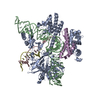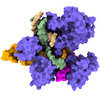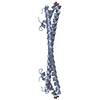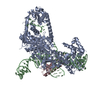+ データを開く
データを開く
- 基本情報
基本情報
| 登録情報 |  | |||||||||
|---|---|---|---|---|---|---|---|---|---|---|
| タイトル | CryoEM structure of HpaCas9-sgRNA-dsDNA in the presence of AcrIIC4 | |||||||||
 マップデータ マップデータ | ||||||||||
 試料 試料 |
| |||||||||
 キーワード キーワード | Cas9 / cleavage inhibition / ANTIMICROBIAL PROTEIN / HYDROLASE-RNA-ANTIMICROBIAL PROTEIN complex | |||||||||
| 機能・相同性 |  機能・相同性情報 機能・相同性情報maintenance of CRISPR repeat elements / endonuclease activity / defense response to virus / 加水分解酵素; エステル加水分解酵素 / DNA binding / RNA binding / metal ion binding 類似検索 - 分子機能 | |||||||||
| 生物種 |  Haemophilus parainfluenzae (パラインフルエンザ菌) / synthetic construct (人工物) Haemophilus parainfluenzae (パラインフルエンザ菌) / synthetic construct (人工物) | |||||||||
| 手法 | 単粒子再構成法 / クライオ電子顕微鏡法 / 解像度: 3.1 Å | |||||||||
 データ登録者 データ登録者 | Sun W / Cheng Z / Wang J / Yang X / Wang Y | |||||||||
| 資金援助 |  中国, 1件 中国, 1件
| |||||||||
 引用 引用 | ジャーナル: mBio / 年: 2018 タイトル: Potent Cas9 Inhibition in Bacterial and Human Cells by AcrIIC4 and AcrIIC5 Anti-CRISPR Proteins. 著者: Jooyoung Lee / Aamir Mir / Alireza Edraki / Bianca Garcia / Nadia Amrani / Hannah E Lou / Ildar Gainetdinov / April Pawluk / Raed Ibraheim / Xin D Gao / Pengpeng Liu / Alan R Davidson / Karen ...著者: Jooyoung Lee / Aamir Mir / Alireza Edraki / Bianca Garcia / Nadia Amrani / Hannah E Lou / Ildar Gainetdinov / April Pawluk / Raed Ibraheim / Xin D Gao / Pengpeng Liu / Alan R Davidson / Karen L Maxwell / Erik J Sontheimer /   要旨: In their natural settings, CRISPR-Cas systems play crucial roles in bacterial and archaeal adaptive immunity to protect against phages and other mobile genetic elements, and they are also widely used ...In their natural settings, CRISPR-Cas systems play crucial roles in bacterial and archaeal adaptive immunity to protect against phages and other mobile genetic elements, and they are also widely used as genome engineering technologies. Previously we discovered bacteriophage-encoded Cas9-specific anti-CRISPR (Acr) proteins that serve as countermeasures against host bacterial immunity by inactivating their CRISPR-Cas systems (A. Pawluk, N. Amrani, Y. Zhang, B. Garcia, et al., Cell 167:1829-1838.e9, 2016, https://doi.org/10.1016/j.cell.2016.11.017). We hypothesized that the evolutionary advantages conferred by anti-CRISPRs would drive the widespread occurrence of these proteins in nature (K. L. Maxwell, Mol Cell 68:8-14, 2017, https://doi.org/10.1016/j.molcel.2017.09.002; A. Pawluk, A. R. Davidson, and K. L. Maxwell, Nat Rev Microbiol 16:12-17, 2018, https://doi.org/10.1038/nrmicro.2017.120; E. J. Sontheimer and A. R. Davidson, Curr Opin Microbiol 37:120-127, 2017, https://doi.org/10.1016/j.mib.2017.06.003). We have identified new anti-CRISPRs using the same bioinformatic approach that successfully identified previous Acr proteins (A. Pawluk, N. Amrani, Y. Zhang, B. Garcia, et al., Cell 167:1829-1838.e9, 2016, https://doi.org/10.1016/j.cell.2016.11.017) against Cas9 (NmeCas9). In this work, we report two novel anti-CRISPR families in strains of and , both of which harbor type II-C CRISPR-Cas systems (A. Mir, A. Edraki, J. Lee, and E. J. Sontheimer, ACS Chem Biol 13:357-365, 2018, https://doi.org/10.1021/acschembio.7b00855). We characterize the type II-C Cas9 orthologs from and , show that the newly identified Acrs are able to inhibit these systems, and define important features of their inhibitory mechanisms. The Acr is the most potent NmeCas9 inhibitor identified to date. Although inhibition of NmeCas9 by anti-CRISPRs from and reveals cross-species inhibitory activity, more distantly related type II-C Cas9s are not inhibited by these proteins. The specificities of anti-CRISPRs and divergent Cas9s appear to reflect coevolution of their strategies to combat or evade each other. Finally, we validate these new anti-CRISPR proteins as potent off-switches for Cas9 genome engineering applications. As one of their countermeasures against CRISPR-Cas immunity, bacteriophages have evolved natural inhibitors known as anti-CRISPR (Acr) proteins. Despite the existence of such examples for type II CRISPR-Cas systems, we currently know relatively little about the breadth of Cas9 inhibitors, and most of their direct Cas9 targets are uncharacterized. In this work we identify two new type II-C anti-CRISPRs and their cognate Cas9 orthologs, validate their functionality and in bacteria, define their inhibitory spectrum against a panel of Cas9 orthologs, demonstrate that they act before Cas9 DNA binding, and document their utility as off-switches for Cas9-based tools in mammalian applications. The discovery of diverse anti-CRISPRs, the mechanistic analysis of their cognate Cas9s, and the definition of Acr inhibitory mechanisms afford deeper insight into the interplay between Cas9 orthologs and their inhibitors and provide greater scope for exploiting Acrs for CRISPR-based genome engineering. | |||||||||
| 履歴 |
|
- 構造の表示
構造の表示
| 添付画像 |
|---|
- ダウンロードとリンク
ダウンロードとリンク
-EMDBアーカイブ
| マップデータ |  emd_34919.map.gz emd_34919.map.gz | 22.2 MB |  EMDBマップデータ形式 EMDBマップデータ形式 | |
|---|---|---|---|---|
| ヘッダ (付随情報) |  emd-34919-v30.xml emd-34919-v30.xml emd-34919.xml emd-34919.xml | 25.7 KB 25.7 KB | 表示 表示 |  EMDBヘッダ EMDBヘッダ |
| 画像 |  emd_34919.png emd_34919.png | 138.6 KB | ||
| Filedesc metadata |  emd-34919.cif.gz emd-34919.cif.gz | 8 KB | ||
| その他 |  emd_34919_half_map_1.map.gz emd_34919_half_map_1.map.gz emd_34919_half_map_2.map.gz emd_34919_half_map_2.map.gz | 18.1 MB 18.1 MB | ||
| アーカイブディレクトリ |  http://ftp.pdbj.org/pub/emdb/structures/EMD-34919 http://ftp.pdbj.org/pub/emdb/structures/EMD-34919 ftp://ftp.pdbj.org/pub/emdb/structures/EMD-34919 ftp://ftp.pdbj.org/pub/emdb/structures/EMD-34919 | HTTPS FTP |
-検証レポート
| 文書・要旨 |  emd_34919_validation.pdf.gz emd_34919_validation.pdf.gz | 914.5 KB | 表示 |  EMDB検証レポート EMDB検証レポート |
|---|---|---|---|---|
| 文書・詳細版 |  emd_34919_full_validation.pdf.gz emd_34919_full_validation.pdf.gz | 914.1 KB | 表示 | |
| XML形式データ |  emd_34919_validation.xml.gz emd_34919_validation.xml.gz | 10.1 KB | 表示 | |
| CIF形式データ |  emd_34919_validation.cif.gz emd_34919_validation.cif.gz | 12 KB | 表示 | |
| アーカイブディレクトリ |  https://ftp.pdbj.org/pub/emdb/validation_reports/EMD-34919 https://ftp.pdbj.org/pub/emdb/validation_reports/EMD-34919 ftp://ftp.pdbj.org/pub/emdb/validation_reports/EMD-34919 ftp://ftp.pdbj.org/pub/emdb/validation_reports/EMD-34919 | HTTPS FTP |
-関連構造データ
- リンク
リンク
| EMDBのページ |  EMDB (EBI/PDBe) / EMDB (EBI/PDBe) /  EMDataResource EMDataResource |
|---|---|
| 「今月の分子」の関連する項目 |
- マップ
マップ
| ファイル |  ダウンロード / ファイル: emd_34919.map.gz / 形式: CCP4 / 大きさ: 23.8 MB / タイプ: IMAGE STORED AS FLOATING POINT NUMBER (4 BYTES) ダウンロード / ファイル: emd_34919.map.gz / 形式: CCP4 / 大きさ: 23.8 MB / タイプ: IMAGE STORED AS FLOATING POINT NUMBER (4 BYTES) | ||||||||||||||||||||||||||||||||||||
|---|---|---|---|---|---|---|---|---|---|---|---|---|---|---|---|---|---|---|---|---|---|---|---|---|---|---|---|---|---|---|---|---|---|---|---|---|---|
| 投影像・断面図 | 画像のコントロール
画像は Spider により作成 | ||||||||||||||||||||||||||||||||||||
| ボクセルのサイズ | X=Y=Z: 1.04 Å | ||||||||||||||||||||||||||||||||||||
| 密度 |
| ||||||||||||||||||||||||||||||||||||
| 対称性 | 空間群: 1 | ||||||||||||||||||||||||||||||||||||
| 詳細 | EMDB XML:
|
-添付データ
-ハーフマップ: #2
| ファイル | emd_34919_half_map_1.map | ||||||||||||
|---|---|---|---|---|---|---|---|---|---|---|---|---|---|
| 投影像・断面図 |
| ||||||||||||
| 密度ヒストグラム |
-ハーフマップ: #1
| ファイル | emd_34919_half_map_2.map | ||||||||||||
|---|---|---|---|---|---|---|---|---|---|---|---|---|---|
| 投影像・断面図 |
| ||||||||||||
| 密度ヒストグラム |
- 試料の構成要素
試料の構成要素
-全体 : Complex of HpaCas9-sgRNA-DNA in the presence of AcrIIC4
| 全体 | 名称: Complex of HpaCas9-sgRNA-DNA in the presence of AcrIIC4 |
|---|---|
| 要素 |
|
-超分子 #1: Complex of HpaCas9-sgRNA-DNA in the presence of AcrIIC4
| 超分子 | 名称: Complex of HpaCas9-sgRNA-DNA in the presence of AcrIIC4 タイプ: complex / ID: 1 / 親要素: 0 / 含まれる分子: #1-#5 |
|---|---|
| 由来(天然) | 生物種:  Haemophilus parainfluenzae (パラインフルエンザ菌) Haemophilus parainfluenzae (パラインフルエンザ菌) |
| 分子量 | 理論値: 194 KDa |
-超分子 #2: HpaCas9/AcrIIC4
| 超分子 | 名称: HpaCas9/AcrIIC4 / タイプ: complex / ID: 2 / 親要素: 1 / 含まれる分子: #1, #5 |
|---|
-超分子 #3: RNA/DNA
| 超分子 | 名称: RNA/DNA / タイプ: complex / ID: 3 / 親要素: 1 / 含まれる分子: #2-#4 |
|---|
-分子 #1: CRISPR-associated endonuclease Cas9
| 分子 | 名称: CRISPR-associated endonuclease Cas9 / タイプ: protein_or_peptide / ID: 1 詳細: Two mutations D13A and H581A were introduced to inactivate the catalytic sites of HpaCas9. The first residue 'Ser' of the sample sequence is the one expressed from the vector left after tag cleavage. コピー数: 1 / 光学異性体: LEVO |
|---|---|
| 由来(天然) | 生物種:  Haemophilus parainfluenzae (パラインフルエンザ菌) Haemophilus parainfluenzae (パラインフルエンザ菌) |
| 分子量 | 理論値: 121.605695 KDa |
| 組換発現 | 生物種:  |
| 配列 | 文字列: SMENKNLNYI LGLALGIASV GWAVVEIDEK ENPLRLIDVG VRTFERAEVP KTGESLALSR RLARSARRLT QRRVARLKKA KRLLKSENI LLSTDERLPH QVWQLRVEGL DHKLERQEWA AVLLHLIKHR GYLSQRKNES KSENKELGAL LSGVDNNHKL L QQATYRSP ...文字列: SMENKNLNYI LGLALGIASV GWAVVEIDEK ENPLRLIDVG VRTFERAEVP KTGESLALSR RLARSARRLT QRRVARLKKA KRLLKSENI LLSTDERLPH QVWQLRVEGL DHKLERQEWA AVLLHLIKHR GYLSQRKNES KSENKELGAL LSGVDNNHKL L QQATYRSP AELAVKKFEV EEGHIRNQQG AYTHTFSRLD LLAEMELLFS RQQHFGNPFA SEKLLENLTA LLMWQKPALS GE AILKMLG KCTFEDEYKA AKNTYSAERF VWITKLNNLR IQENGLERAL NDNERLALME QPYDKNRLFY SQVRSILKLS DEA IFKGLR YSGEDKKAIE TKAVLMEMKA YHQIRKVLEG NNLKAEWAEL KANPTLLDEI GTAFSLYKTD EDISAYLAGK LSQP VLNAL LENLSFDKFI QLSLKALYKL LPLMQQGLRY DEACREIYGD HYGKKTEENH HFLPQIPADE IRNPVVLRTL TQARK VING VVRLYGSPAR IHIETGREVG KSYKDRRELE KRQEENRKQR ENAIKEFKEY FPHFAGEPKA KDILKMRLYK QQNAKC LYS GKPIELHRLL EKGYVEVDAA LPFSRTWDDS FNNKVLVLAN ENQNKGNLTP FEWLDGKHNS ERWRAFKALV ETSAFPY AK KQRILSQKLD EKGFIERNLN DTRYVARFLC NFIADNMHLT GEGKRKVFAS NGQITALLRS RWGLAKSRED NDRHHALD A VVVACSTVAM QQKITRFVRF EAGDVFTGER IDRETGEIIP LHFPTPWQFF KQEVEIRIFS DNPKLELENR LPDRPQANH EFVQPLFVSR MPTRKMTGQG HMETVKSAKR LNEGISVIKM PLTKLKLKDL ELMVNREREK DLYDTLKARL EAFNDDPAKA FAEPFIKKG GAIVKSVRVE QIQKSGVLVR EGNGVADNAS MVRVDVFTKG GKYFLVPIYT WQVAKGILPN KAATQYKDEE D WEVMDNSA TFKFSLHPND LVKLVTKKKT ILGYFNGLNR ATGNIDIKEH DLDKSKGKQG IFEGVGIKLA LSFEKYQVDE LG KNIRLCK PSKRQPVR UniProtKB: CRISPR-associated endonuclease Cas9 |
-分子 #5: anti-CRISPR protein AcrIIC4
| 分子 | 名称: anti-CRISPR protein AcrIIC4 / タイプ: protein_or_peptide / ID: 5 詳細: WP_049372635.1;The first residue 'Ser' of the sample sequence is the one expressed from the vector left after tag cleavage. コピー数: 1 / 光学異性体: LEVO |
|---|---|
| 由来(天然) | 生物種:  Haemophilus parainfluenzae (パラインフルエンザ菌) Haemophilus parainfluenzae (パラインフルエンザ菌) |
| 分子量 | 理論値: 10.072395 KDa |
| 組換発現 | 生物種:  |
| 配列 | 文字列: SMKITSSNFA TIATSENFAK LSVLPKNHRE PIKGLFKSAV EQFSSARDFF KNENYSKELA EKFNKEAVNE AVEKLQKAID LAEKQGIQF |
-分子 #2: sgRNA
| 分子 | 名称: sgRNA / タイプ: rna / ID: 2 詳細: RNA is originally derived from Haemophilus parainfluenzae and modified by author. コピー数: 1 |
|---|---|
| 由来(天然) | 生物種: synthetic construct (人工物) |
| 分子量 | 理論値: 40.860125 KDa |
| 配列 | 文字列: GGUCACUCUA ACAUUUAAUC ACACGUUGUA GCUCCCUUUU UCGAAAGAAA AACGUUGUUA CAAUAAGAGA AAAGAUUUCU CGCAAAGCU CUGUCCCUUG AAAUGUAAGU UUCAAGGGAC AUCUUUUUC |
-分子 #3: target strand
| 分子 | 名称: target strand / タイプ: dna / ID: 3 / コピー数: 1 / 分類: DNA |
|---|---|
| 由来(天然) | 生物種:  Haemophilus parainfluenzae (パラインフルエンザ菌) Haemophilus parainfluenzae (パラインフルエンザ菌) |
| 分子量 | 理論値: 10.865029 KDa |
| 配列 | 文字列: (DT)(DG)(DA)(DA)(DA)(DT)(DC)(DA)(DT)(DA) (DT)(DG)(DT)(DG)(DT)(DG)(DA)(DT)(DT)(DA) (DA)(DA)(DT)(DG)(DT)(DT)(DA)(DG)(DA) (DG)(DT)(DG)(DA)(DC)(DC) |
-分子 #4: non-target strand
| 分子 | 名称: non-target strand / タイプ: dna / ID: 4 / コピー数: 1 / 分類: DNA |
|---|---|
| 由来(天然) | 生物種:  Haemophilus parainfluenzae (パラインフルエンザ菌) Haemophilus parainfluenzae (パラインフルエンザ菌) |
| 分子量 | 理論値: 10.766954 KDa |
| 配列 | 文字列: (DG)(DG)(DT)(DC)(DA)(DC)(DT)(DC)(DT)(DA) (DA)(DC)(DA)(DT)(DT)(DT)(DA)(DA)(DT)(DG) (DT)(DG)(DT)(DG)(DA)(DT)(DA)(DT)(DG) (DA)(DT)(DT)(DT)(DC)(DA) |
-実験情報
-構造解析
| 手法 | クライオ電子顕微鏡法 |
|---|---|
 解析 解析 | 単粒子再構成法 |
| 試料の集合状態 | particle |
- 試料調製
試料調製
| 緩衝液 | pH: 7.5 構成要素:
| |||||||||
|---|---|---|---|---|---|---|---|---|---|---|
| 凍結 | 凍結剤: ETHANE / チャンバー内湿度: 100 % / チャンバー内温度: 277 K |
- 電子顕微鏡法
電子顕微鏡法
| 顕微鏡 | FEI TITAN KRIOS |
|---|---|
| 撮影 | フィルム・検出器のモデル: GATAN K2 QUANTUM (4k x 4k) 平均電子線量: 60.0 e/Å2 |
| 電子線 | 加速電圧: 300 kV / 電子線源:  FIELD EMISSION GUN FIELD EMISSION GUN |
| 電子光学系 | 照射モード: FLOOD BEAM / 撮影モード: BRIGHT FIELD / 最大 デフォーカス(公称値): 1.6 µm / 最小 デフォーカス(公称値): 1.0 µm |
| 実験機器 |  モデル: Titan Krios / 画像提供: FEI Company |
+ 画像解析
画像解析
-原子モデル構築 1
| 精密化 | プロトコル: RIGID BODY FIT |
|---|---|
| 得られたモデル |  PDB-8hnv: |
 ムービー
ムービー コントローラー
コントローラー








 Z (Sec.)
Z (Sec.) Y (Row.)
Y (Row.) X (Col.)
X (Col.)





































